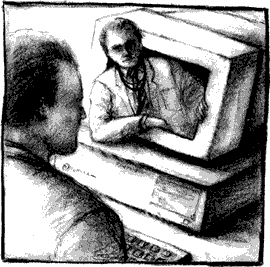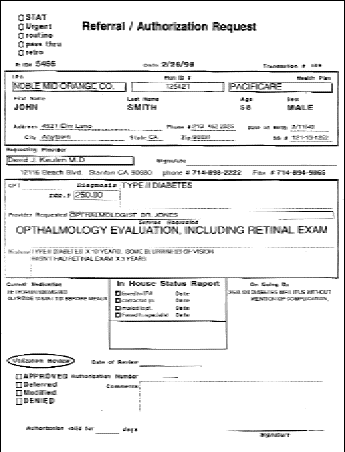
Here's how one family physician used his computer to simplify the referral process.
Fam Pract Manag. 1998;5(4):31-34

Referring patients isn't as simple as it used to be, thanks in large part to the sheer number of entities with which practices must now communicate. On a normal day, my busy primary care practice accommodates between 30 and 40 patients. We operate in a managed care environment, have capitated contracts with at least four different IPAs and deal with several government-funded agencies. Each IPA and agency has its own panel of referral specialists, labs and imaging facilities and its own unique utilization review (UR) process and authorization forms. This creates a challenge for us, as it does for most primary care practices.
The way things were
Until recently, the referral process in my practice went something like this: After I saw a patient in the exam room, I would make a notation on the patient's chart indicating that the patient needed to be referred to the appropriate source for secondary care. Staff would then have to identify the correct authorization form for the patient's health plan, retrieve the correct form from its storage cubby, fill in the patient's information and eventually pass the form back to me. As the referring physician, I would then indicate what services were required, along with the appropriate diagnosis code(s) and CPT code if I knew them. I would also try to provide any additional clinical history that might prove useful. Next, my staff would fax the form to the appropriate IPA, and we would await a reply. Overall, the process required too much paper shuffling and too much guesswork by my staff.
As a primary care physician who serves on the board of two IPAs and is directly involved in UR of other physicians' referral requests, I know that most requests come to the UR committee only partially complete, handwritten and often illegible (perhaps due to the quality of the fax and duplication process or because the note was hastily scrawled). Requests that offer insufficient information regarding the patient's history or the reason for the request are particularly problematic. In this era of intense scrutiny of services, any request that causes even the least bit of doubt is almost always sent back to the referring physician for clarification or additional information. This of course delays the referral for the patient even further while the physician's staff awaits authorization or attempts to telephone the IPA or other entity to determine the status of the request. Ultimately, this status may or may not be recorded in the patient's chart.
And then there was one
I decided to try to improve this obviously cumbersome and inefficient system. My idea was to design a standard referral request form that could be filled out electronically in our office. All our patient charts are maintained in a computerized database using FileMaker Pro software. This commercially available and inexpensive relational-database program is not designed specifically for medical practices, but it offers us a relatively simple and effective way to computerize our charts. Like many other database programs, our system captures all the essential data on our patients and then allows us to organize that information into new formats as needed. While a practice could create a standardized referral form without having computerized patient records, the fact that our records were already in the database certainly eased the process for our practice and maximized the effectiveness of our form.
Since we already had three separate database files to record patient information, encounter data and diagnoses (ICD-9), respectively, it was fairly easy to create a referral file to track referrals and generate our new form (see “A computer-generated referral form”). When a patient needs a referral, we create a new record in the referral file. Next, we input the patient's ID number, which automatically pulls relevant data from the patient's file and places it into the referral file. This way, we do not waste time re-entering standard data, such as the patient's name, age, sex, ongoing diagnosis, current medications and current health plan (see “The easy way to input data”). I then fill in the fields indicating the desired specialist or treatment and add whatever supporting clinical history is relevant. Most important, because I have a computer in the exam room, I can complete this task during the examination at the time of referral. This means that my reasons for the referral and my choice of words, not those of the medical assistant or the front office staff, are entered into the file. Other benefits are that the comments are typewritten and legible. Once I complete the referral form in the exam room, I simply print it on the network printer, and it comes out at the front office with the referral date automatically printed on the form.
A computer-generated referral form
The author has created this standardized authorization form to ease the referral process in his practice. To generate a new form, the author simply creates a new record in the electronic referral file, enters the patient's ID number (which pulls in the majority of the patient's data from the patient's file) and fills in the few remaining fields.

Our referral form also includes fields for the IPA's use, such as status of authorization, authorization date and comments. We've also created fields our front office can use, including the date we faxed the referral request, the date we received a reply, and when and how we contacted the patient. We enter all this information in the database so that any member of our staff can immediately determine the status of any authorization request.
We designed our referral form to include most of the elements that the various referral forms had in common. In addition, we formatted some of the fields in extra-large print, such as the field that indicates what is being requested, so that UR committees would have no problems immediately identifying what we want.
The easy way to input data
Because the author's standardized referral form is connected to a computerized patient record, the following fields can be lifted from the patient record simply by keying in the patient's ID number. This eliminates the need to re-key information the computer system has already captured.
Automated fields:
Patient's name
Age
Sex
Address
Phone number
Date of birth
Social Security number IPA
Plan ID number
Health plan
Primary care provider
Current medication
Ongoing diagnosis
Favorable reviews
Prior to using the form, I contacted some of the IPAs to alert them to the new format; for all others, we simply sent them the new form without explanation. Remarkably, the form was immediately accepted without comment by essentially everyone. What's more, the approval rate of our initial referral requests is close to 100 percent, with few requests for clarification or additional information. While I pride myself on requesting only appropriate referrals and procedures, this high rate also illustrates the importance of supplying UR committees with appropriate information in a legible, organized manner.
Using the computerized referral form has dramatically reduced staff confusion regarding which forms to use and has enabled me to track the status of authorizations immediately. Because we now have complete referral data recorded in our database, we can review referrals on a regular basis to assure that they are being processed in a timely manner. Perhaps most important, the new form has changed my attitude regarding referrals from one of dread at filling out yet another form to a feeling that I can now quickly and easily expedite this part of my patients' care.